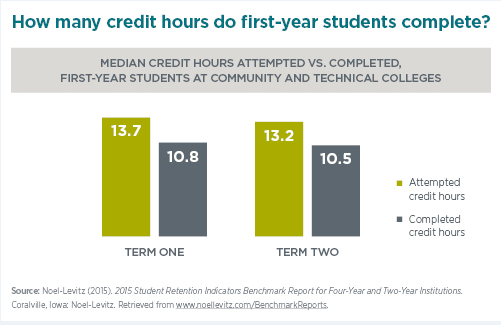enrollment
Taking a closer look at community college completion indicators
Recently I spent two days at a community college providing professional development workshops on trends in higher education for community colleges. I met with more than 50 professionals at the college who were eager to understand the higher education landscape and, most importantly, how their performance on key indicators fits within the national community college context.
We examined a number of key indicators, including term-to-term persistence and year-to-year retention, two of the most common metrics used to measure quality and to set targets for improvement. The metric that got their attention in new ways, however, was the percentage of credit hours earned vs. credit hours attempted. While some of the participants were aware of the importance of this (mainly colleagues in financial aid who have to monitor adequate progress for federal loan guidelines), many had not considered whether or not “slow” progress (actually earning fewer credit hours than those attempted) could have an impact on student success.
The data we examined came from the 2015 Student Retention Indicators Benchmark Report for Four-Year and Two-Year Institutions. These benchmark data indicate that in the first term of enrollment, students at community colleges complete on average 80 percent of the credit hours they attempted (10.8 hours completed vs. 13.7 hours attempted). And this pattern continues in the second term with an average completion rate of 79 percent (10.5 hours completed vs. 13.2 hours attempted).

Why is this important and why did this get the attention of the people at the community college I visited? First, many were surprised that these data indicate that some students who start out full-time end up being part-time by the end of the semester. Second, the data led to a conversation about students’ patterns of enrollment—if students intend to be full-time, with a goal of graduating in a calculated amount of time, what does dropping courses and reducing the number of credit hours earned per semester do to their overall goal of earning a degree? A number of advisors suggested that perhaps this was a good strategy. They offered examples of students who encounter difficult courses and rather than ending the term with a lower GPA opt to drop a course in order to protect their academic record, even though their credit-earning progress will be impacted. But the information they shared was anecdotal; yes, there were examples of individual cases in which that appeared to be the right decision for the student, but there were no trend data to substantiate this.
The 80 percent completion rate also got some attention in this discussion. When this was calculated in terms of additional time to degree, we determined it will take these students at least 20 percent longer to earn their degrees than if they were completing more credits in their first term of enrollment.
Possible solutions to increase credit hour completion
Next, our conversation turned to solutions—what can be done to help more students earn more credit hours in a more timely manner? We discussed a number of options:
- Encourage students to register for more than the minimum number of credit hours to be full-time. Fifteen hours vs. twelve hours can make a big difference in the long run.
- Examine the structure of when courses are offered. Are there sufficient short-term courses available to start at the middle of the term so that students can still drop a class but add one in the same term as well?
- Develop “credit recovery” options—again here we discussed short-term course options, as well as blending learning opportunities and maximizing options to learn year-round.
- Create alert systems that pick up “slow progress” students, as already happens with low GPA students. Utilize advising to target students making “slow progress” to develop intervention strategies to help students recover their momentum toward their degrees as soon as possible.
More information about the importance of carrying a full-time course load and its impact on community college success can be found in the new report Predicting Student Retention at Community Colleges by Dr. Karen C. Miller.
Want to learn more? Join us for a webinar on May 5 for community colleges
I am sure there are other strategies you are using to address progression issues with your students, and I encourage you to share these by commenting on this blog post or by joining our upcoming webinar:
Webinar, Tuesday, May 5 at 2:00 p.m. Eastern:
Enhancing the Success of Community College Students: How Data from Motivational Assessments and Satisfaction Assessments Can Guide Your Strategies
You are also invited to join us this summer at our National Conference on Student Recruitment, Marketing, and Retention, July 7-8, in Boston.
Questions? Want to discuss college completion indicators for your campus? Please feel free to email me or call me at 1-800-876-1117. I hope you have found this post helpful to your important work with students at community colleges.